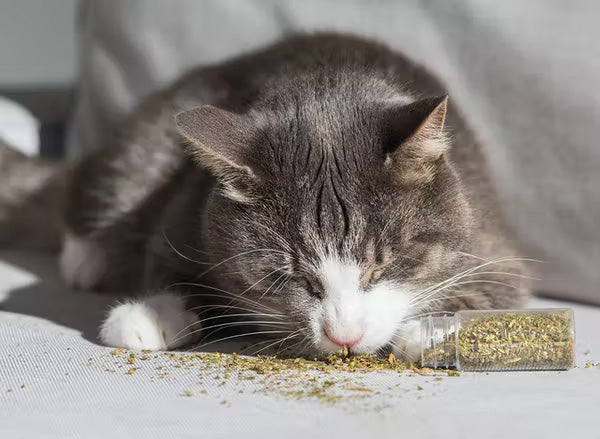Chances are, if you have a cat (or even if you don’t have one!), you’ve heard of catnip and its mysterious effects that it can have on feline friends. But what is catnip? What does it actually do for your cat?
We’re answering all of your questions about it in this article!
What is catnip?
Catnip, formally known as nepeta cataria, is a perennial herb that is native to Europe, Central Asia, and the Middle East. It’s a member of the mint family, and it can grow up to three feet tall. Other than being a great addition to your cat’s life, it’s also often used in gardens thanks to its drought resistant and mosquito deterring properties.
If you love to garden, you can easily grow it yourself. Or, you can buy it dried, infused in cat toys, and as sprays.
How does catnip work?
Catnip works as a stimulant for most cats. It contains an essential oil called nepetalactone which enters the brain through the cat’s nose and mouth when they sniff or eat it. Then it binds to the olfactory bulb in the brain. The olfactory bulb sends information to the amygdala and the pituitary glands in the brain, resulting in what’s known as a “high.”
How does catnip affect my cat?
Cats stimulated by the herb will lick, roll around, sniff, chew, shake their head, and rub their cheeks, chin, and body. Some cats will even vocalize, jump, and run around!
But, the actual effect of it depends on each individual cat. Typically, if your cat is more laid back, he’ll become even more relaxed and docile when stimulated by it. Very rarely do cats become aggressive when stimulated with it. The reaction to it is not long-lasting. It’s a relatively short amount of time that cats are stimulated from catnip - usually only 10-15 minutes!
Do all cats like catnip?
Nope! Believe it or not, not all cats like the herb. The stimulation to catnip is actually genetic! About 75% of all cats, though, do have a reaction or are stimulated by it.
Kittens are not particularly fond or impressed with catnip, either. That’s because the reaction to it is a hormonal one. So, most cats won’t react to it until they’ve reached sexual maturity, which is about six months old.

Is catnip safe and healthy for cats?
Catnip is absolutely safe for cats to smell and ingest. It’s considered non addictive, nontoxic, and completely healthy for them, too!
There is no “dose” for cats to use, but it’s always a good idea to start with smaller amounts to see how they react at first. You might find that your cat is one of the few who doesn’t really care for it at all. Either way, your cat will more than likely walk away from it when he’s had enough of it.
For the rare cat who does overindulge in it, you might notice some small side effects like an upset tummy. If your feline friend does have an adverse reaction to catnip, be sure to remove all infused toys, sprays, or dried leaves from his area.
Cats can also build up a tolerance to catnip. If they do, the effects of catnip will diminish significantly. To keep this from happening, we suggest only using catnip once every few weeks or so. And definitely no more than once per week. When you’re not actively using it, keep it in a sealed container where your cat can’t get into it.
What are the health benefits of catnip for cats?
For many cats, it can help as a stress reliever and a relaxer. It helps to ease anxiety and depression, both of which cats are susceptible to. Catnip also has plenty of vitamins and minerals in it to help with your cat’s health!
 So, how do you apply catnip to your cat’s scratching post?
So, how do you apply catnip to your cat’s scratching post?
Sprinkle catnip near the scratching post
Sprinkle dried leaves on the base of the post, on top of it, and even in the fabric of the post as best you can. They’ll be able to smell it on and near the post, which will entice them to it. Once they’re there, and they’re ready to stretch out their muscles, they’ll use the post to do so!
Hang bags of catnip on the scratching post
You can also hang bags of dried catnip on your cat’s scratching post, as well. Just like with sprinkling it around and on the post, hanging bags of it will entice them towards the scratching post.
Use a catnip spray on the scratching post
Finally, you can use a spray and lightly spritz the fabric of the post. Like with the dried leaves, the smell of it will draw your cat closer to the post. A natural reaction to catnip is the desire to knead their paws. They’ll do just that right on the scratching post!
Catnip is perfectly healthy, nontoxic, and non addictive to cats, and it offers plenty of health benefits for them.
Need some more tips, tricks, and advice for caring for your cat? Discover our cat training tips.







